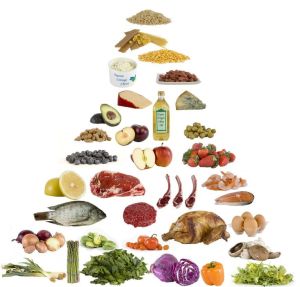Do you have to diet to lose weight?
By Diana Kelly
The Rumor: You have to go on a strict diet to lose weight
It's fitting that "diet" has four letters because, for many of us, it's a curse word. We associate dieting with punishment, starvation, beating ourselves up, avoiding any fun social activities, and basically, waiting until it’s over and we can start living our lives again -- in leaner bodies, of course. In 2012, there were 108 million people on diets in the United States. To help them reach their goals, Americans spent about $20 billion on the weight-loss industry, including diet books, diet drugs, and weight-loss surgeries.
Is it necessary, though? Can you lose weight without being on a diet? We talked to nutrition experts Amy Jamieson Petonic, RD, of the Academy of Nutrition and Dietetics, and the Nutrition Twins, Tammy Lakatos Shames and Lyssie Lakatos, upwave's diet and fitness experts, for their tips on how to shed pounds the healthy way and keep them off for good.
The Verdict: The most effective weight loss involves lifestyle changes, not crash diets. Change what You eat and change what you do.
“Successful weight loss isn’t all-or-nothing thinking,” says Lakatos. “Dieting is a temporary thing that you think you’re on or off of. When you tell yourself you can have this and you can’t have that, oftentimes it winds up backfiring. People end up giving in and eventually binging on the foods they avoided because it’s very hard to be extremely restrictive for a long period of time.”
“But healthy eating is a lifestyle,” says Lakatos Shames. “Focus on healthy options of what you know you should eat. If you concentrate on eating fruits, vegetables, lean proteins, and whole grains, there is less room for desserts and junk in your meals. Focusing on what you can’t eat is the dieting mentality.”
When I started to make progress in my battle with weight, I changed to a whole-food diet. What is that you might ask. Eating whole foods is eating food as close as possible to its natural state. I would only eat fruit and vegetables that I could touch and smell in the store. I didn't buy anything in a box, bag, or can. I bought fresh meat. I didn't buy any prepackaged meat. I stopped buying lunch meat or packaged cheese. I wasn't buying anything with a label. I stopped drinking anything with calories. I stopped cheating on the weekends. I ate all I wanted but I only ate whole foods. I picked all my food from the food pyramid below. It gives you several choices. I ate what I wanted and avoided some of the things I didn't want. Look on the right side for the brackets. Some foods you can eat every day, some once a week, and others once a month. I lost 20 pounds in a few months. Everyone can't expect the same results but If you stick to your plan you will see results in a couple months. At first, don't expect much the body has to get accustomed to the changes in your diet.
“Dieting [has] such a negative association with food,” says Petonic. “When you begin to associate good, whole foods with pleasure, weight loss will happen with very little effort,” Petonic suggests eating these foods to help you lose weight without dieting:
Whole grains: Eat 100 percent whole-wheat bread, whole-wheat pasta, or brown rice. All provide essential B vitamins and minerals that will fill you up and keep your energy levels high.
Quinoa: It’s a complete plant protein that gives you all nine essential amino acids and is packed with fiber and iron.
Salmon: This protein source is high in omega-3 fatty acids DHA and EPA, which are anti-inflammatory, and they provide essential proteins for growth and development.
Pistachios: These protein-packed nuts may help increase your metabolic rate and promote fat burning.
But don’t forget to get moving! Exercise is just as important as nutrition because that’s how you burn calories, says Lakatos. “Exercising is how you speed up your metabolic rate and get your body going. We’ve found that when our clients exercise, they feel good about themselves, and they don’t want to undo their hard work by eating the wrong foods.”
Follow me on X, the former Twitter, @ray0369 to get a link to my latest posts.
If you want to lose your body fat look for my e-books at the websites listed below. You’ll get information on Healthy eating, exercise, and diet. Instead of spending hours on the internet reading dozens of posts, you can save time by picking up one of my e-books. There are two e-books. “How Bad Do You Want To Lose Weight?” is available at all the online bookstores selling for $3.99. Go to any of the websites below and search the title to find my e-book. This book gives you all you need to lose weight without spending money on gym memberships, diet plans, or meal plans.
Look for my first book at Amazon.com, bn.com, iBooks, Kobo.com, Scribd.com, or Gardner Books in the U.K.
My new e-book is available on Smashwords.com and other online bookstores. Just type “getting to a Healthy Weight” in the search box at the top of the home page.
Look for my podcast by searching “How Bad Do You Want To Lose Weight” on the podcast app that you use. You’ll see a piece of my book cover.








